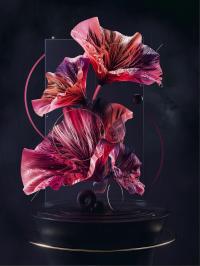
To begin with, it must be made clear that NFTs (non-fungible tokens) are not a new art form. They are simply the digital representations of any kind of product. In the context of the exhibition at TyanHaus the products in questions were works of art.
They are linked to a particular blockchain, Ethereum [a cryptocurrency second only to Bitcoin] and they are a good test case as to how the global trading of goods may evolve with the rise of digital currencies. What a collector will get when buying an NFT is something like a certificate of authenticity or a deed, and this is recorded on the blockchain, [a database shared among the nodes of a computer network]. It appears to be the logical extension of developments famously discussed in Walter Benjamin’s seminal essay The work of art in the age of mechanical reproduction (1935). The emergence of digital technology and the phenomenon of NFTs once again question the connection between the authenticity and the ‘aura’ of an artwork. Benjamin suggested that “even the most perfect reproduction of a work of art is lacking in one element: Its presence in time and space, its unique existence at the place where it happens to be.”
Few of today’s digital natives will concern themselves with the ‘aura’ of an artwork, and will instead appreciate NFTs as an exciting extension of the traditional art market. As the exhibition organisers, TyanHaus, a group of friends collaborating as a DAO, (decentralized autonomous organization, governed by code instead of leaders) explained, this new market place offers many flexible trading options, some of which will clearly benefit the artists. Joanne Hollings, a young Auckland-based photographer, was one of the first New Zealanders to join the SuperRare digital trading platform, and she can now practice her craft full-time, no day-job required.
The exhibition at TyanHaus provided a well thought-out introduction to the NFT art market with engaging images that had little in common with the pixilated, simple Crypto Punk NFTs which, for reasons we cannot discuss here, attract price tags in the million-dollar range. The overall impression of this exhibition was one of high energy, exuberance, and diversity. No one style or genre dominated the show and not all were presented in a digital, on-screen format. One of the most memorable works was Flosia, an animated still-life by Materium. It captured my attention because of its well-balanced combination of rich colour and unobtrusive elements of background movement. Overall, the crew behind TyanHaus made a strong case for the possibilities of the NFT art market, and its potential benefits for collectors and artists alike.
DETAILS
inHaus Exhibition,
TyanHaus, 6 Carlyle Street, Sydenham
21 January 2022
SuperRare: https://editorial.superrare.com/2022/01/07/new-artists-on-superrare-55//
IMAGE
- Flosia, Materium, digital animation
